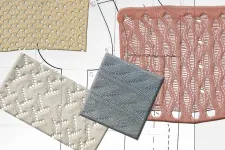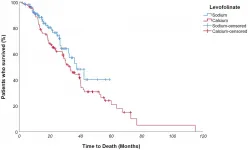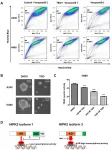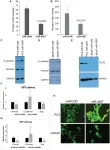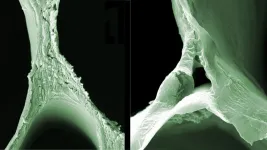INFORMATION:
The international team included researchers from MIT, Polytechnic University of Turin in Italy, U.S. Army Combat Capabilities Development Command Soldier Center, Dana Farber Cancer Institute, INRIM Istituto Nazionale di Ricerca Metrologica in Italy, Defense Agency for Technology and Quality in South Korea, and Monterrey Institute of Technology and Higher Education in Mexico.
This research was supported, in part, by the U.S. Army Research Office, the
Advanced Functional Fabrics of America (AFFOA) Institute, MIT International Science and Technology Initiatives (MISTI), the MIT Deshpande Center, and the MIT-Tecnológico de Monterrey Nanotechnology Program.
Written by Jennifer Chu, MIT News Office
Could we recycle plastic bags into fabrics of the future?
Engineers have developed self-cooling fabrics from polyethylene, a material commonly used in plastic bags
2021-03-15
(Press-News.org) In considering materials that could become the fabrics of the future, scientists have largely dismissed one widely available option: polyethylene.
The stuff of plastic wrap and grocery bags, polyethylene is thin and lightweight, and could keep you cooler than most textiles because it lets heat through rather than trapping it in. But polyethylene would also lock in water and sweat, as it's unable to draw away and evaporate moisture. This antiwicking property has been a major deterrent to polyethylene's adoption as a wearable textile.
Now, MIT engineers have spun polyethylene into fibers and yarns designed to wick away moisture. They wove the yarns into silky, lightweight fabrics that absorb and evaporate water more quickly than common textiles such as cotton, nylon, and polyester.
They have also calculated the ecological footprint that polyethylene would have if it were produced and used as a textile. Counter to most assumptions, they estimate that polyethylene fabrics may have a smaller environmental impact over their life cycle than cotton and nylon textiles.
The researchers hope that fabrics made from polyethylene could provide an incentive to recycle plastic bags and other polyethylene products into wearable textiles, adding to the material's sustainability.
"Once someone throws a plastic bag in the ocean, that's a problem. But those bags could easily be recycled, and if you can make polyethylene into a sneaker or a hoodie, it would make economic sense to pick up these bags and recycle them," says Svetlana Boriskina, a research scientist in MIT's Department of Mechanical Engineering.
Boriskina and her colleagues have published their findings today in Nature Sustainability.
Water wick
A molecule of polyethylene has a backbone of carbon atoms, each with a hydrogen atom attached. The simple structure, repeated many times over, forms a Teflon-like architecture that resists sticking to water and other molecules.
"Everyone we talked to said polyethylene might keep you cool, but it wouldn't absorb water and sweat because it rejects water, and because of this, it wouldn't work as a textile," Boriskina says.
Nevertheless, she and her colleagues tried to make weavable fibers from polyethylene. They started with polyethylene in its raw powder form and used standard textile manufacturing equipment to melt and extrude polyethylene into thin fibers, similar to turning out strands of spaghetti. Surprisingly, they found that this extrusion process slightly oxidized the material, changing the fiber's surface energy so that polyethylene became weakly hydrophilic, and able to attract water molecules to its surface.
The team used a second standard extruder to bunch multiple polyethylene fibers together to make a weavable yarn. They found that, within a strand of yarn, the spaces between fibers formed capillaries through which water molecules could be passively absorbed once attracted to a fiber's surface.
To optimize this new wicking ability, the researchers modeled the properties of the fibers and found that fibers of a certain diameter, aligned in specific directions throughout yarn, improved the fibers' wicking ability.
Based on their modeling, the researchers made polyethylene yarn with more optimized fiber arrangements and dimensions, then used an industrial loom to weave the yarn into fabrics. They then tested the wicking ability of polyethylene fabric over cotton, nylon, and polyester by dipping strips of the fabrics in water and measuring the time it took for the liquid to wick, or climb up each strip. They also placed each fabric on a scale over a single water droplet and measured its weight over time as the water was wicked through the fabric and evaporated.
In every test, polyethylene fabrics wicked away and evaporated the water faster than other common textiles. The researchers did observe that polyethylene lost some of its water-attracting ability with repeated wetting, but by simply applying some friction, or exposing it to ultraviolet light, they induced the material to become hydrophilic again.
"You can refresh the material by rubbing it against itself, and that way it maintains its wicking ability," Boriskina says. "It can continuously and passively pump away moisture."
Eco cycle
The team also found a way to incorporate color into the polyethylene fabrics, which has been a challenge, again due to the material's resistance to binding with other molecules, including traditional inks and dyes. The researchers added colored particles into the powdered polyethylene before extruding the material into fiber form. In this way, particles were encapsulated within the fibers, successfully imparting color to them.
"We don't need to go through the traditional process of dyeing textiles by dunking them in solutions of harsh chemicals," Boriskina says. "We can color polyethylene fibers in a completely dry fashion, and at the end of their life cycle, we could melt down, centrifuge, and recover the particles to use again."
The team's dry-coloring process contributes to the relatively small ecological footprint that polyethylene would have if it were used to make textiles, the researchers say. The team calculated this footprint by using a life cycle assessment tool commonly used by the textile industry. Taking into account polyethylene's physical properties and the processes required to make and color the fabrics, the researchers found it would require less energy to produce polyethylene textiles, compared to polyester and cotton.
"Polyethylene has a lower melting temperature so you don't have to heat it up as much as other synthetic polymer materials to make yarn, for example," Boriskina explains. "Synthesis of raw polyethylene also releases less greenhouse gas and waste heat than synthesis of more conventional textile materials such as polyester or nylon. Cotton also takes a lot of land, fertilizer, and water to grow, and is treated with harsh chemicals, which all comes with a huge ecological footprint."
In its use phase, polyethylene fabric could also have a smaller environmental impact, she says, as it would require less energy to wash and dry the material compared with cotton and other textiles.
"It doesn't get dirty because nothing sticks to it," Boriskina says. "You could wash polyethyelene on the cold cycle for 10 minutes, versus washing cotton on the hot cycle for an hour."
The team is exploring ways to incorporate polyethylene fabrics into lightweight, passively cooling athletic apparel, military attire, and even next-generation spacesuits, as polyethylene shields against the harmful X-ray radiation of space.
ELSE PRESS RELEASES FROM THIS DATE:
Melting glaciers could speed up carbon emissions into the atmosphere
2021-03-15
The loss of glaciers worldwide enhances the breakdown of complex carbon molecules in rivers, potentially contributing further to climate change.
An international research team led by the University of Leeds has for the first time linked glacier-fed mountain rivers with higher rates of plant material decomposition, a major process in the global carbon cycle.
As mountain glaciers melt, water is channelled into rivers downstream. But with global warming accelerating the loss of glaciers, rivers have warmer water temperatures and are less prone to variable water flow and sediment movement. These conditions are then much more favourable for fungi to establish and ...
Open door to treatment of renal fibrosis by showing that it is caused by telomere shortening
2021-03-15
Ageing is a common factor in many diseases. So, what if it were possible to treat them by acting on the causes of ageing or, more specifically, by acting on the shortening of telomeres, the structures that protect chromosomes? This strategy is being pursued by the Telomeres and Telomerase Group of the Spanish National Cancer Research Centre (CNIO), which has already succeeded to cure pulmonary fibrosis and infarctions in mice by lengthening telomeres. Now they take a first step towards doing the same with renal fibrosis by demonstrating that short telomeres are at the origin of this disease, ...
Oncotarget: Folinic acid in colorectal cancer: Esquire or fellow knight?
2021-03-15
Oncotarget published "Folinic acid in colorectal cancer: esquire or fellow knight? Real-world results from a mono institutional, retrospective study" which reported that the stock of therapeutic weapons available in metastatic colorectal cancer has been progressively grown over the years, with improving both survival and patients' clinical outcome: notwithstanding advances in the knowledge of mCRC biology, as well as advances in treatment, fluoropyrimidine antimetabolite drugs have been for 30 years the mainstay of chemotherapy protocols for this malignancy.
5-Fluorouracil seems to act differently depending on administration method: elastomer-mediated continuous infusion better inhibits Thymidylate ...
Oncotarget: A novel isoform of Homeodomain-interacting protein kinase-2
2021-03-15
Oncotarget published "A novel isoform of Homeodomain-interacting protein kinase-2 promotes YAP/TEAD transcriptional activity in NSCLC cells" which reported that In this study, the authors show that a new HIPK2 isoform increases TEAD reporter activity in NSCLC cells.
They detected and cloned a novel HIPK2 isoform 3 and found that its forced overexpression promotes TEAD reporter activity in NSCLC cells.
Expressing HIPK2 isoform 3_K228A kinase-dead plasmid failed to increase TEAD reporter activity in NSCLC cells.
Next, they showed that two siRNAs targeting HIPK2 decreased HIPK2 isoform 3 and YAP protein levels in NSCLC cells.
In summary, this Oncotarget study indicates that HIPK2 isoform 3, the main HIPK2 isoform ...
Oncotarget: MicroRNA-4287 is controlling epithelial-to mesenchymal transition in prostate cancer
2021-03-15
The cover for issue 51 of Oncotarget features Figure 5, "miR-4287 overexpression regulates EMT in prostate cancer cell lines," published in "MicroRNA-4287 is a novel tumor suppressor microRNA controlling epithelial-to mesenchymal transition in prostate cancer" by Bhagirath, et al. which reported that the authors analyzed the role of miR-4287 in PCa using clinical tissues and cell lines.
Receiver operating curve analysis showed that miR-4287 distinguishes prostate cancer from normal with a specificity of 88.24% and with an Area under the curve of 0.66. Further, these authors found that miR-4287 ...
In severe COVID, cytokine "hurricane" in lung attracts damaging inflammatory cells
2021-03-15
NEW YORK, NY (March 15, 2021)--A cytokine "hurricane" centered in the lungs drives respiratory symptoms in patients with severe COVID-19, a new study by immunologists at Columbia University Vagelos College of Physicians and Surgeons suggests.
Two cytokines, CCL2 and CCL3, appear critical in luring immune cells, called monocytes, from the bloodstream into the lungs, where the cells launch an overaggressive attempt to clear the virus.
Targeting these specific cytokines with inhibitors may calm the immune reaction and prevent lung tissue damage. Currently, one drug that blocks immune responses to CCL2 is being studied in clinical trials of patients with severe COVID-19.
Survivors of severe COVID-19, the study also found, had a greater abundance of antiviral T cells in their lungs ...
Significant variation found in timing andselection of genetic tests for non--small-cell lung cancer
2021-03-15
Philadelphia, March 15, 2021 - Biomarker testing surveys specific disease-associated molecules to predict treatment response and disease progression; however its use has complicated the diagnosis of non-small-cell lung cancer (NSCLC). In a new study in The Journal of Molecular Diagnosis, published by Elsevier, investigators provide for the first time a complete overview of biomarker testing, spanning multiple treatment lines, in a single cohort of patients.
Using exploratory data analysis and process-mining techniques in a real-world setting, investigators identified significant variation in test utilization and treatment. They also found that while ...
Study reveals new clues about the architecture of X chromosomes
2021-03-15
BOSTON - Researchers at Massachusetts General Hospital (MGH) have uncovered new clues that add to the growing understanding of how female mammals, including humans, "silence" one X chromosome. Their new study, published in Molecular Cell, demonstrates how certain proteins alter the "architecture" of the X chromosome, which contributes to its inactivation. Better understanding of X chromosome inactivation could help scientists figure out how to reverse the process, potentially leading to cures for devastating genetic disorders.
Female mammals have two copies of the X chromosome in all of their cells. Each X chromosome contains many genes, but only one of the pair ...
Voltage from the parquet
2021-03-15
Ingo Burgert and his team at Empa and ETH Zurich has proven it time and again: Wood is so much more than "just" a building material. Their research aims at extending the existing characteristics of wood in such a way that it is suitable for completely new ranges of application. For instance, they have already developed high-strength, water-repellent and magnetizable wood. Now, together with the Empa research group of Francis Schwarze and Javier Ribera, the team has developed a simple, environmentally friendly process for generating electricity from a type of wood sponge, as they reported last week in the journal Science Advances.
Voltage through deformation
If you want to generate electricity ...
NASA images reveal important forests and wetlands are disappearing in Belize
2021-03-15
AUSTIN, Texas -- Using NASA satellite images and machine learning, researchers with The University of Texas at Austin have mapped changes in the landscape of northwestern Belize over a span of four decades, finding significant losses of forest and wetlands, but also successful regrowth of forest in established conservation zones that protect surviving structures of the ancient Maya.
The research serves as a case study for other rapidly developing and tropical regions of the globe, especially in places struggling to balance forest and wetland conservation with agricultural needs and food security.
"Broad-scale global studies show that tropical deforestation and wetland destruction is occurring ...
LAST 30 PRESS RELEASES:
Tracing the quick synthesis of an industrially important catalyst
New software sheds light on cancer’s hidden genetic networks
UT Health San Antonio awarded $3 million in CPRIT grants to bolster cancer research and prevention efforts in South Texas
Third symposium spotlights global challenge of new contaminants in China’s fight against pollution
From straw to soil harmony: International team reveals how biochar supercharges carbon-smart farming
Myeloma: How AI is redrawing the map of cancer care
Manhattan E. Charurat, Ph.D., MHS invested as the Homer and Martha Gudelsky Distinguished Professor in Medicine at the University of Maryland School of Medicine
Insilico Medicine’s Pharma.AI Q4 Winter Launch Recap: Revolutionizing drug discovery with cutting-edge AI innovations, accelerating the path to pharmaceutical superintelligence
Nanoplastics have diet-dependent impacts on digestive system health
Brain neuron death occurs throughout life and increases with age, a natural human protein drug may halt neuron death in Alzheimer’s disease
SPIE and CLP announce the recipients of the 2025 Advanced Photonics Young Innovator Award
Lessons from the Caldor Fire’s Christmas Valley ‘Miracle’
Ant societies rose by trading individual protection for collective power
Research reveals how ancient viral DNA shapes early embryonic development
A molecular gatekeeper that controls protein synthesis
New ‘cloaking device’ concept to shield sensitive tech from magnetic fields
Researchers show impact of mountain building and climate change on alpine biodiversity
Study models the transition from Neanderthals to modern humans in Europe
University of Phoenix College of Doctoral Studies releases white paper on AI-driven skilling to reduce burnout and restore worker autonomy
AIs fail at the game of visual “telephone”
The levers for a sustainable food system
Potential changes in US homelessness by ending federal support for housing first programs
Vulnerability of large language models to prompt injection when providing medical advice
Researchers develop new system for high-energy-density, long-life, multi-electron transfer bromine-based flow batteries
Ending federal support for housing first programs could increase U.S. homelessness by 5% in one year, new JAMA study finds
New research uncovers molecular ‘safety switch’ shielding cancers from immune attack
Bacteria resisting viral infection can still sink carbon to ocean floor
Younger biological age may increase depression risk in older women during COVID-19
Bharat Innovates 2026 National Basecamp Showcases India’s Most Promising Deep-Tech Ventures
Here’s what determines whether your income level rises or falls
[Press-News.org] Could we recycle plastic bags into fabrics of the future?Engineers have developed self-cooling fabrics from polyethylene, a material commonly used in plastic bags
